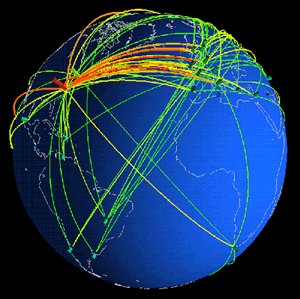The Origins of the Internet
1. Page 1
Roughly speaking most people are familiar with the history of the Internet. In its efforts to produce a nuclear-proof communication system the American government assigned the development of a multi-node communication system that would not be operated by a specific center, to the well known RAND (Research And Development) research center. Thus, in case of a node been struck by the enemy the network would be operational when bypassing the faulty node. That simple, and ingenious at the same time idea, was met with terrifying opposition when it came to be realized, as the network architect, Paul Baran, has revealed in an interview of his, for the Wired magazine: the biggest threat for the new network, Baran says, was not the USSR, but the AT&T, the telephone company with exclusive rights in the USA. The irony of it was, that the company did not respond negatively due to the fact that it was in position of foreseeing the ominous future in store for it, but because its executives could not…comprehend what the network was. The philosophy of hierarchy prevailed at the time. Even a communication network that would not comply with a specific chain of command seemed absurd.
Reminiscing the dark, owing to the cold war, as well as productive period of the early 1960s, Paul Baran comes up with some amazing facts linked with the birth of the Internet, all those details that made history. He remembers that the RAND building was planned by the mathematician John Williams in such a way that all the routes between any two of its premises would produce the highest possible number of accidental encounters amongst researchers. “The system worked”, he says. “It is a hard task indeed, to try and bring together people with different skills-during that period RAND was the place of work for a number of people whose fields of expertise ranged from physics to sociology. Yet that institute was the most productive place I have ever come across.”
 The
Internet might have not been brought to existence had that misconception about
the nuclear potential of the Soviet Union not prevailed. Numerous army
officers, probably driven by motives having to do with their personal interests,
had overstated the nuclear threat rooted in the USSR. They had been talking
about communist Russia’s huge potential to blow lethal strikes against
the USA and so on, a claim to be proved false after the launch of military
satellites. Panic was spread when missiles, and more specifically the intercontinental
ballistic ones started being fed with solid fuel. Prior to that, while the
use of liquid fuel was in process, intelligence on fueling missiles would easily
reach the countries involved. Now, with the use of solid fuels the missiles
were in full operational readiness any time, any place. In case of a nuclear
war all radio communication would cease since the ionosphere would be disrupted
for an hour. The inland communication centers were specific (and as a matter
of fact known to the Soviets), therefore in case of a sudden attack, no order
for retaliation could be given. Thus, military authorities in both sides got
involved in a research race aiming to build a network that would be invulnerable
to nuclear attack.
The
Internet might have not been brought to existence had that misconception about
the nuclear potential of the Soviet Union not prevailed. Numerous army
officers, probably driven by motives having to do with their personal interests,
had overstated the nuclear threat rooted in the USSR. They had been talking
about communist Russia’s huge potential to blow lethal strikes against
the USA and so on, a claim to be proved false after the launch of military
satellites. Panic was spread when missiles, and more specifically the intercontinental
ballistic ones started being fed with solid fuel. Prior to that, while the
use of liquid fuel was in process, intelligence on fueling missiles would easily
reach the countries involved. Now, with the use of solid fuels the missiles
were in full operational readiness any time, any place. In case of a nuclear
war all radio communication would cease since the ionosphere would be disrupted
for an hour. The inland communication centers were specific (and as a matter
of fact known to the Soviets), therefore in case of a sudden attack, no order
for retaliation could be given. Thus, military authorities in both sides got
involved in a research race aiming to build a network that would be invulnerable
to nuclear attack.













